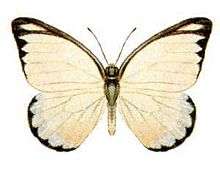Appias ada
| Rare albatross | |
|---|---|
 | |
| Scientific classification | |
| Kingdom: | Animalia |
| Phylum: | Arthropoda |
| Class: | Insecta |
| Order: | Lepidoptera |
| Family: | Pieridae |
| Genus: | Appias |
| Species: | A. ada |
| Binomial name | |
| Appias ada (Stoll, [1781]) | |
| Synonyms | |
| |
Appias ada, the rare albatross, is a butterfly of the family Pieridae. It is found on the Moluccas, New Guinea, Indonesia and in Australia and the Solomon Islands.
Subspecies
- Appias ada ada
- Appias ada thasia (Papua)
- Appias ada caria (north-eastern Australia)
- Appias ada solstitialis
Description
The wingspan of males is 59 mm, while in females it is 54 mm.[1] Upper segment of the forewings are white with a black costa, as well as black dots along the margin. Males have a white dot near the apex. The hind wings also have black margins, however are coloured a pale yellow. The underside of both male and female forewings are white with a black costa, while hindwing undersides are yellow. In the female, the black sections of the underside are larger, and the apex of the forewing is more rounded.[2] A. ada males are visually similar to those of D. ennia, especially the subspecies D. e. tindalti, both of which occur in the Cape York region of Australia.[3] The distinguishing feature is the lack of orange spots on the hind wing's underside.
Life Cycle
Eggs: Laid singularly, placed on the young shoots of their food source. Shaped like a spindle (height of 1 mm, width of 0.5mm), and initially white, they change to orange before hatching. Larva: 35 mm long; blue-green body, with "numerous blue conical tubercles, a yellow middorsal line, and a white ventrolateral line".[4] The head is pale yellow, with blue stripes. Feed on the young shoots of Crateva religiosa, also known as Temple Plant.[5] It does not survive if fed older leaves. Pupa: 27mm long. Yellow with black dorsal spots. Black spine with a white cremaster.[6] Life cycle is completed within three weeks of summer: egg 4 days, larva 10 days, pupa 6 days [7]
Ecology
Occurrence records show the habitat of A. ada to range from open woody trees to sparse grasses.[8] Of the various species, only A. a. caria is apparent in Australia, to which it is endemic.[9] The larva rests on the midrib of a leaf, spinning a slik pad on which it sits.[10] Adults often fly rapidly along watercourses, and have been recorded all months excluding March.[11] The mitochondrial genome for A. ada has been sequenced.[12]
See also
- Australian Butterflies
- Insects
References
- ↑ Braby, M., 2000, 'Butterflies of Australia: Their Identification, Biology and Distribution'
- ↑ Braby, M., 2000, 'Butterflies of Australia: Their Identification, Biology and Distribution'
- ↑ Braby, M., 2000, 'Butterflies of Australia: Their Identification, Biology and Distribution'
- ↑ Braby, M., 2000, 'Butterflies of Australia: Their Identification, Biology and Distribution'
- ↑ http://lepidoptera.butterflyhouse.com.au/pier/ada.html
- ↑ Braby, M., 2000, 'Butterflies of Australia: Their Identification, Biology and Distribution'
- ↑ Braby, M., 2000, 'Butterflies of Australia: Their Identification, Biology and Distribution'
- ↑ http://bie.ala.org.au/species/urn:lsid:biodiversity.org.au:afd.taxon:29a6f6d0-c595-4641-9879-77bb996fd717#records
- ↑ http://lepidoptera.butterflyhouse.com.au/pier/ada.html
- ↑ Braby, M., 2000, 'Butterflies of Australia: Their Identification, Biology and Distribution'
- ↑ Braby, M., 2000, 'Butterflies of Australia: Their Identification, Biology and Distribution'
- ↑ https://www.ncbi.nlm.nih.gov/nuccore/KF404537.1